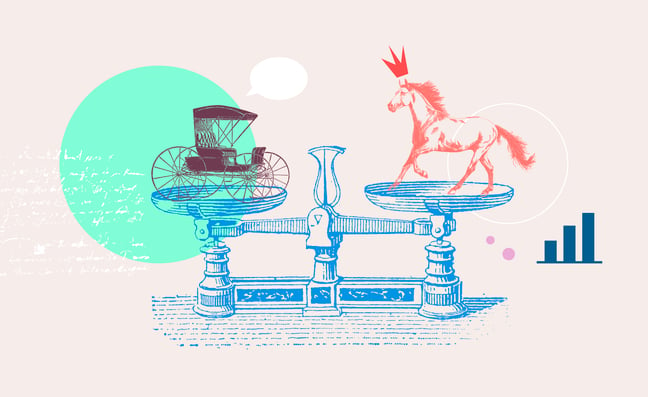Putting The Cart Before The Horse: Customer Feedback Vs Vision
Approx 4 min. read
%20(1).jpg)
"If I had asked people what they wanted, they would have asked for a faster horse."
This is a quote famously attributed to Henry Ford to describe the initial success of Ford Motor Company. It has sparked many a conversation on the merits of genius and creativity versus the “the customer is always right” mentality.
It is a history lesson many of us may not need, but maybe we can all settle on the premise that revolutionary ingenuity can only take you so far. It gets you in the race, perhaps even leading the pack, but what gets you to the finish line? Some may say it’s “the vision thing.” And yes, lackluster brands that can’t break out often do find themselves lacking in the vision department. But what happens when the people know what they want? They eventually start asking for the faster horse, the cheaper horse or decide maybe they don’t want a horse after all—leaving Seabiscuit in the dust.
Interestingly enough, research suggests there is no actual evidence this quote came from Ford’s own mouth. But this anecdote doesn’t stop us from getting curious about the mechanics behind this existential dance between vision and customer feedback and why you may want to get curious if you are putting one in front of the other.
Fast forward to 1997, the company we know of as Netflix was founded by Reed Hastings and Marc Randolph. Legend has it that after paying $40 in late fees for renting Apollo 13, the idea for an internet-driven media platform was born. In the late ‘90s, who would have predicted a company relying on the US Postal Service to deliver their product would go on to become one of the world’s largest media companies and produce Oscar-winning performances in 2023? Blockbusting success came from years of balancing unique vision and customer feedback.
“Was not obvious at the time, even to me, but we had one thing that Blockbuster did not: a culture that valued people over process, emphasized innovation over efficiency, and had very few controls. Our culture, which focused on achieving top performance with talent density and leading employees with context not control, has allowed us to continually grow and change as the world, and our members’ needs, have likewise morphed around us.”
― Reed Hastings, No Rules Rules: Netflix and the Culture of Reinvention
The “Vision Thing”
Vision is an essential tenet when building an organization, company, or brand. It is your compass, your guiding light. Without it how do you find direction and purpose? A strong vision typically is directly proportional to the impact of messaging and strength of growth. “Why?” you may ask. How else do you write a prescription for the future?

“Leadership requires focusing on what George H. W. Bush once dismissively called the ‘vision thing.’ Leaders communicate and help shape a common vision, whether for better or for worse.”
– Douglas Hicks (Oxford Academic, 2009)
CEO Reed Hastings is quoted saying “We named our company Netflix in 1998 because we believed Internet-based movie rental represented the future, first as a means of improving service and selection, and then as a means of movie delivery.’
Customer feedback is not what creates markets, if a product doesn’t exist it is an individual or group’s vision that builds it and offers it. Trouble comes when you limit vision. When markets and technology shift, survival is based on the ‘pivot.’ Adapt or die. Netflix doubled down on technology before it was mainstream. The remote with the Netflix logo didn’t exist, smart TVs didn’t exist, the internet was all dial-up, and “You’ve got mail.” It was a huge risk, but the payoff was epic.
A hatchling company can not operate on customer feedback because they (your customers) likely don’t exist yet. This is where the strength of vision comes in. At its inception, Netflix used the collective anger for late fees, a shared truth, and accessed a daily ritual in almost everyone’s lives—checking the mailbox. But it took years to build their success, to even get in the green. When you’re in the race, then the feedback loop emerges, and it’s continuous.
The Dilemma of Customer Feedback
It is undeniable, ignoring or limiting customer feedback is not an option when looking to achieve growth as a company or a brand. It is a “proceed at your own risk” mentality. When looking to balance customer feedback, your business mission and vision play an integral role.
For Netflix, they want to “entertain the world.” How is that achieved other than knowing what would entertain the world? For example, a show getting canceled after one season is a very rudimentary example of this. If viewers stop watching after an episode or two, or viewership is low, there is no reason to invest in another season, no matter how great production feels about the material just wouldn't make “cents.”

What is the inverse of this? Look at the wildfire success of the show La Casa de Papel. Initially aired on Spanish TV in 2017 with declining viewership, Netflix paid pennies on the dollar for the show, infused it with cash, recut the original episodes, and renamed the show Money Heist. Sound familiar now? It went on to become the most-watched non-English show at the time. If Netflix polled American viewers for content they most wanted to see, would they have gotten the answer “A Spanish language crime drama?” In 2020 it surpassed the infamous Tiger King with a reported 65 million views and a residency in the US Top 10 category. Netflix is Maximus screaming at the arena “Are you not entertained?”
Balancing Customer Feedback with Vision
Henry Ford and his Model T is both a success story and a cautionary tale. Ignoring customer feedback was both the making and the undoing. The importance of finding a balance between customer feedback and product vision is essential. There are techniques for incorporating customer feedback without sacrificing your unique vision. Over-emphasizing customer feedback can lead to a crowd-sourced build-a-bear that looks nothing like your original mission and can feel inauthentic.

So what is the metric of success? Is it quarterly growth of sales? Is it readership or viewership or the number of clients on any given day? The key metric is the lifespan and survival of a brand. How well do you balance product vision with customer satisfaction? It is possible to make achievements by not stepping into your customer's shoes or asking for user feedback i.e. Henry Ford and the Model T. But will it scale? Will it sustain you? History suggests not.
Now we’ve got you chewing on the importance of juggling customer feedback and vision, perhaps you’re scratching your head: which is the cart and which is the horse? Well you need both, and it's less of a race and more of a dance. Now you’ve heard the why, stay tuned for future posts on how to elicit authentic and valuable customer feedback to get you leading the pack. For now, Henry Ford leaves you with some food for thought: “Whether you think you can or you think you can’t, you’re right.”
Related posts
Food for thought.

How to Collect Customer Feedback And Use It To Craft Your Company Vision
by Balogun Olabode Jr
.jpg)